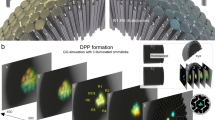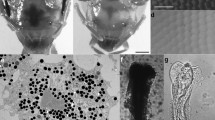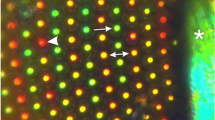Summary
The large visual fields of the compound eyes of the Malayan flyCyrtodiopsis dalmanni overlap 3–4 mm in front of the eyes. Depth perception of objects placed within the visual fields of both eyes is therefore very probable. Interferometrical studies on theCyrtodiopsis eye indicated that refractive indices of the ommatidial structures are the same as in the blowfly. The focal length of the dioptric apparatus of the stalked-eye fly ommatidium was found to be 29 μm on the object side. The angles of aperture calculated from this focal length and from the diameters of the corresponding rhabdomeric prolongations—located in the focal plane-are 2.5° for the rhabdomeres 1–6, and 1.6° for the rhabdomere 7. These opening angles are smaller than those of the ommatidia, which are about 8.8°. Calculations based on the diffraction theory lead to the conclusion that higher resolution is obtained in the single ommatidium because the airy disc covers only one rhabdomeric prolongation.
Zusammenfassung
Die großen Sehfelder der Komplexaugen der malayischen StielaugenfliegeCyrtodiopsis dalmanni überschneiden sich 3–4 mm vor den Augen. Eine Entfernungswahrnehmung von Objekten, die sich in den Sehfeldern beider Facettenaugen befinden, ist deshalb sehr wahrscheinlich.
Interferometrische Messungen amCyrtodiopsis-Auge führten zu gleichen Brechungsquotienten für die Ommatidienstrukturen wie beiCalliphora erythrocephala. Die geometrischoptischen Berechnungen ergaben für den dioptrischen Apparat des Ommatidiums imCyrtodiopsis-Auge eine objektseitige Brennweite von 29 μm. Hieraus und aus den Durchmessern der Rhabdomeren-Kappen — sie liegen in der Brennebene — resultieren die Öffnungswinkel von2,5° für die Rhabdomere 1–6 und von1,6° für das 7. Rhabdomer. Diese Öffnungswinkel sind kleiner als die der Ommen, die bei8,8° liegen. Im einzelnen Ommatidium kann eine höhere Auflösung erzielt werden, da die Beugungsscheibe jeweils nur eine Kappe bedeckt.
Similar content being viewed by others
Literatur
Bergmann, L., Schaefer, Cl.: Lehrbuch der Experimentalphysik, 4. Aufl., Bd. III. Berlin: W. de Gruyter & Co. 1966
Bruggen, A. C. van: Diptera (Brachycera) Diopsidae. South African animal life. Results of the Lund. Univ. Expedition in 1950–1951, vol.VIII, 415–439 (1961)
Burkhardt, D.: Electrophysiological studies on the compound eye of a stalked-eye fly,Cyrtodiopsis dalmanni Wiedemann (Diopsidae, Diptera). J. comp. Physiol.81, 203–214 (1972)
Burkhardt, D., Darnhofer-Demar, B., Fischer, K.: Zum binokularen Entfernungssehen der Insekten. 1. Die Struktur des Sehraumes von Synsekten. J. comp. Physiol.87, 165–188 (1973)
Burkhardt, D., Gewecke, M.: Mechanoreception in Arthropoda: the chain from stimulus to behavioral pattern. Cold Spr. Harb. Symp. quant. Biol.30, 601–614 (1965)
Dietrich, W.: Die Facettenaugen der Dipteren. Z. wiss. Zool.92, 465–539 (1909)
Eggers, F.: Diopsiden aus Deutsch-Ostafrika. Mit einem Nachwort über die Stielaugen der Diopsiden. Zool. Jb., Syst.49, 469–500 (1925)
Gemperlein, R.: Grundlagen zur genauen Beschreibung von Komplexaugen. Z. vergl. Physiol.65, 428–444 (1969)
Hennig, W.: Die Acalyptratae des Baltischen Bernsteins. Stuttg. Beitr. z. Naturk., Nr.145, August 1965
Kirschfeld, K.: Die Projektion der optischen Umwelt auf das Raster der Rhabdomere im Komplexauge vonMusca. Exp. Brain Res.3, 248–270 (1967)
Langer, H., Schneider, L.: Zur Struktur und Funktion offener Rhabdome in Facettenaugen. Verh. Dtsch. Zool. Ges. (Würzburg) 1969. Zool. Anz., Suppl.33, 494–503 (1970)
Lindner, E.: Ostafrikanische Diopsiden (Dipt.). Jb. Ver. Vaterl. Naturk. Württemberg109, 17–29 (1954)
Lindner, E.: Studien an afrikanischen Diopsiden (Dipt.). Stuttg. Beitr. z. Naturk.94, 1–18 (1962)
Rathmayer, W.: Methylmethacrylat als Einbettungsmedium für Insekten. Experientia (Basel)18, 47–48 (1961)
Reichardt, W.: Über das optische Auflösungsvermögen der Facettenaugen vonLimulus. Kybernetik1, 57–69 (1961)
Schneider, G.: Die Halteren der Schmeißfliege (Calliphora) als Sinnesorgan und als mechanische Flugstabilisatoren. Z. vergl. Physiol.35, 416–458 (1953)
Seitz, G.: Der Strahlengang im Appositionsauge vonCalliphora erythrocephala (Meig.). Z. vergl. Physiol.59, 205–231 (1968)
Seitz, G.: Untersuchungen am dioptrischen Apparat des Leuchtkäferauges. Z. vergl. Physiol.62, 61–74 (1969)
Seitz, G.: Bau und Funktion des Komplexauges der Schmeißfliege. Naturwissenschaften58, 258–265 (1971)
Shillito, J. F.: A note on Speiser's genusCentrioncus and a revised definition of Diopsidae (Diptera: Acalypterae). Proc. roy. ent. Soc. (Lond.), Ser. B19, 109–113 (1950)
Shillito, J. F.: The genera of Diopsidae (Insecta: Diptera). Zool. J. Linnean Soc.50, 287–295 (1971 a)
Shillito, J. F.: Dimorphism in flies with stalked eyes. Zool. J. Linnean Soc.50, 297–305 (1971 b)
Streck, P.: Der Einfluß des Schirmpigmentes auf das Sehfeld einzelner Sehzellen der FliegeCalliphora erythrocephala Meig. Z. vergl. Physiol.76, 372–402 (1972)
Tan, K. B.: The taxonomy, biology, ecology and behaviour of some Malayan Diopsidae (Diptera). Thesis Univ. of Malaya Kuala Lumpur 1965
Trujillo-Cenóz, O.: Some aspects of the structural organization of the arthropod eye. Cold. Spr. Harb. Symp. quant. Biol.30, 371–382 (1965)
Varela, G. F., Wiitanen, W.: The optics of the compound eye of the honey-bee (Apis mellifera). J. gen. Physiol.55, 336–358 (1970)
Wickler, W., Seibt, U.: Zur Ethologie afrikanischer Stielaugenfliegen. Z. Tierpsych.31, 113–130 (1972)
Stavenga, D. G.: Refractiv index of fly rhabdomeres. J. comp. Physiol.91, 417–426 (1974)
Author information
Authors and Affiliations
Additional information
Mit Unterstützung der Deutschen Forschungsgemeinschaft.
Rights and permissions
About this article
Cite this article
Seitz, G., Burkhardt, D. Bau und optische Leistungen des Komplexauges der StielaugenfliegeCyrtodiopsis dalmanni Wiedemann. J. Comp. Physiol. 95, 49–59 (1974). https://doi.org/10.1007/BF00624350
Received:
Issue Date:
DOI: https://doi.org/10.1007/BF00624350




